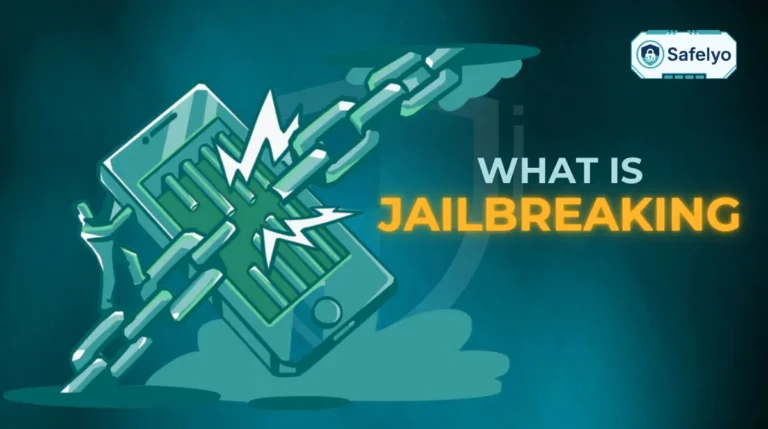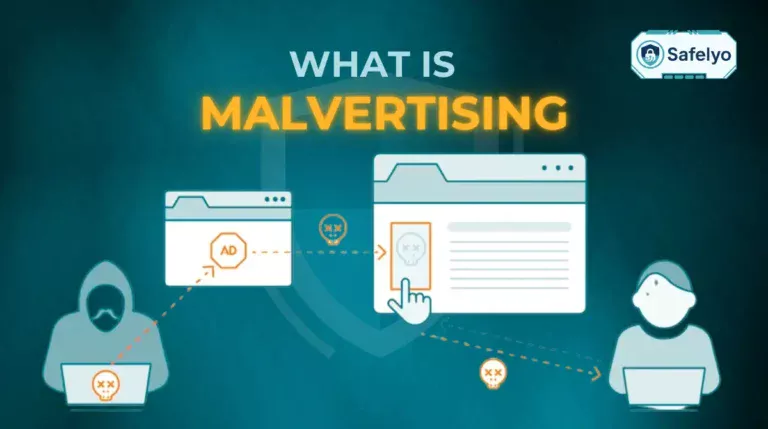What is spyware? Think of it as a silent, digital spy hired to follow you. It’s a type of malicious software that secretly installs itself on your device to monitor your every move – from your private messages and passwords to your physical location – all without your consent.
Unlike loud and disruptive viruses, spyware operates in the shadows. Its only goal is to remain hidden while stealing your most sensitive information. In my years as a cybersecurity analyst, I’ve seen firsthand the distress spyware causes. It’s not just about random hackers; it often feels like a deep personal violation, blurring the line between technology and trust. This isn’t just a tech problem – it’s a human one.
In this comprehensive guide, you will learn:
- The core definition of spyware and how it differs from other malware.
- The four most common types you need to watch out for include stalkerware.
- The clear warning signs that your device might be compromised.
- Actionable steps to find and remove these hidden threats for good.
Don’t let the fear of being watched control you. Let me empower you with the knowledge to reclaim your digital privacy right below.
1. What is spyware?
At its core, spyware is malicious software created with one mission: to secretly observe you, collect your information, and send it to someone else. Its most powerful feature is its absolute stealth. Spyware is designed to be a ghost in your machine, operating silently in the background for as long as possible.
Think of it this way: if ransomware is a burglar kicking down your front door demanding money, spyware is the hidden camera they installed weeks ago, recording everything you do. Its goal isn’t to break your device, but to break your privacy by stealing things like passwords, bank details, private chats, photos, and even your location.
This brings up a tricky question: Is all software that monitors you illegal spyware? Not necessarily. The critical difference boils down to one word: consent. Legitimate software like parental control apps or employee monitoring tools function similarly, but they operate within a legal framework that requires transparency. For example, a company discloses its monitoring policy, or a parent has an open conversation with their child about the tool.
However, the moment these tools are installed on someone’s device without their explicit knowledge and permission – for instance, by a suspicious partner – they cross a serious ethical and legal line. At that point, they become illegal stalkerware, a tool for abuse. In my experience, this is the most personally damaging form of spyware we encounter.
While spyware is a form of malicious software, its intense focus on data theft sets it apart. To see how it fits into the larger threat landscape, you can read our complete overview of what malware is.
2. The 4 common types of spyware you must know
Spyware isn’t a single entity; it comes in various forms, each with a different method and goal. While some are merely annoying, others pose a severe threat to your financial security and personal safety.
To help you quickly understand the landscape, here’s a simple breakdown of the main culprits:
| Spyware Type | Primary Goal | Threat Level |
|---|---|---|
| Adware | Display targeted ads | Low to Medium |
| Keyloggers | Steal typed data | High |
| Trojan Spyware | Deceive and infiltrate | High |
| Stalkerware | Monitor a person’s life | Severe |
Now, let’s dive deeper into what makes each of these tick.
2.1. Adware
Think of adware as that hyper-aggressive salesperson who just won’t leave you alone. It watches your browsing habits – the sites you visit, the products you click on – and then bombards your screen with pop-up ads it thinks you’ll be interested in.
From my experience, most people dismiss adware as just an online nuisance. While it’s the least malicious type on this list, it’s still spyware. It collects your data without clear permission, can severely slow down your computer or browser, and sometimes acts as an open door for more dangerous malware. It’s more annoying than dangerous, but it’s still a privacy risk.
2.2. Keyloggers
This is where spyware becomes truly sinister. A keylogger, or keystroke logger, is software that records every single key you press on your keyboard. Imagine someone is secretly standing over your shoulder, writing down everything you type in a notebook.
That includes your bank account password, your credit card numbers, your private messages on social media, and your confidential work emails. Because they capture information directly from the source, keyloggers are one of the most dangerous and effective forms of spyware for committing identity theft and financial fraud.
2.3. Trojan spyware
The name comes from the ancient tale of the Trojan Horse, and it works exactly the same way. This spyware disguises itself as a legitimate, useful program – like a free video downloader, a game, or even a system “cleaner” app.
You willingly download and install it, thinking you’re getting something helpful. But hidden inside that “gift” is a malicious spyware program that activates once it’s safely inside your system. I’ve seen Trojans that do nothing for weeks, only to later deploy a devastating keylogger. For this reason, deception is its primary weapon.
2.4. Stalkerware (mobile spyware)
This is perhaps the most personal and disturbing category. Stalkerware is an app installed on a mobile phone, usually by someone with physical access to the device – like a controlling partner or an overly intrusive family member. It can secretly track your GPS location, record your phone calls, read your text messages, and see your activity on social media apps.
At Safelyo, we receive countless questions from users who feel they are being watched by someone they know. This is not a distant, anonymous threat; it’s a profound violation of trust and personal safety. The rise of this threat is alarming. In fact, reports from organizations like the Coalition Against Stalkerware show that the use of these invasive apps has surged in recent years, highlighting a growing crisis in digital safety. Stalkerware is an intimate and dangerous invasion of privacy, and knowing how to spot it is crucial.
3. How does spyware get on your device?
Spyware doesn’t just magically appear on your phone or computer. It needs an entry point, and attackers have gotten incredibly clever at creating them. Understanding these weak spots is the first step toward building a strong defense.
Here are the most common ways spyware sneaks past your guard:
Bundled software.
This is a classic trick. You download a free program you actually want, like a PDF converter or a media player. Hidden in the installation process is a tiny, pre-checked box agreeing to install an “optional” browser toolbar or utility. In my experience, this “free gift” is the most common way adware and other potentially unwanted programs get installed.
Phishing and smishing links.
You receive an urgent email or text message (smishing) that looks like it’s from your bank, a delivery service, or a social media site. It prompts you to click a link to “verify your account” or “track your package.” That link leads to a malicious website that silently downloads spyware onto your device. It’s the digital version of a fake notice left in your mailbox, designed to trick you into opening the wrong door.
Software vulnerabilities.
Think of your operating system (like Windows or iOS) or your web browser as a house. A software vulnerability is like an unlocked window or a weak lock on the door. Attackers create spyware to exploit these known weaknesses to get inside without you ever having to click anything. This is why I constantly stress that installing security updates is one of the most critical habits you can develop.
Malicious apps.
These often lurk on unofficial, third-party app stores, but they can sometimes sneak into official ones too. They might promise a “free” version of a paid app or masquerade as a simple game. Once you install them, they unleash the spyware they were hiding. I’ve analyzed apps that looked identical to the real thing but were loaded with data-stealing code.
Physical installation.
This is the primary method for stalkerware. Someone you know gets physical access to your unlocked phone for just a few minutes – perhaps asking to “make a quick call” – and manually installs a hidden tracking app. This direct approach is what makes stalkerware so invasive and difficult to prevent with software alone.
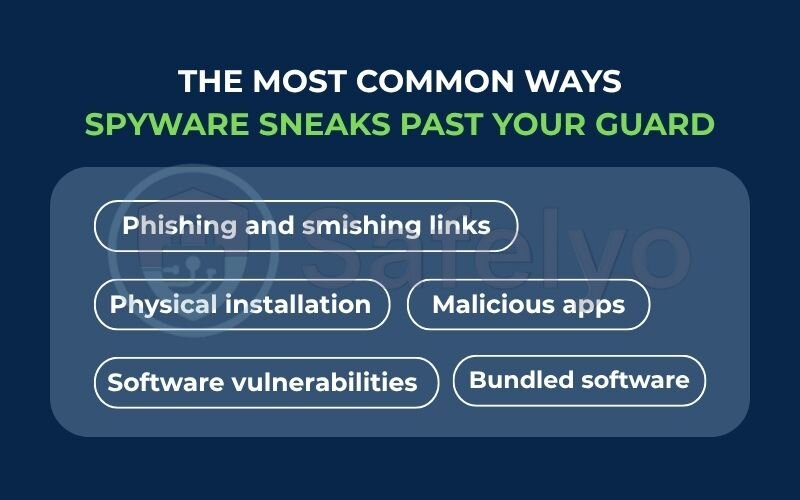
4. The warning signs: how to tell if you have spyware
Because spyware is designed for stealth, detecting it can be tricky. It won’t announce itself with a big, flashy pop-up. Instead, you have to look for the subtle clues it leaves behind. From my years of troubleshooting infected devices, it’s rarely one single issue but rather a pattern of strange behavior that gives it away.
Use this quick checklist to see if your device is showing any of the common red flags.
| Check here | Warning signs |
| ☐ | The device is suddenly very slow or crashes often. |
| ☐ | The battery drains much faster than usual. |
| ☐ | Data usage has increased for no reason. |
| ☐ | Unfamiliar apps or files have appeared. |
| ☐ | The browser homepage or search engine has changed. |
| ☐ | Strange background noises during phone calls. |
| ☐ | The device is active or reboots on its own. |
If you found yourself ticking several of these boxes, it’s time to investigate further. Here’s what those signs mean in more detail:
- Sudden performance drop: Spyware runs constantly in the background, consuming your device’s memory and processing power. This is why apps might freeze or your computer might take forever to boot up when it was fine last week.
- Rapid battery drain: This is a huge red flag, especially on mobile devices. A phone that used to last all day now needs a charge by lunchtime is a classic symptom. Spyware is always working – tracking your location, recording data, or sending it to a server – and that activity eats up your battery. You can often spot the culprit by checking your phone’s battery usage settings.
- Unexplained data increase: Spyware isn’t just collecting your information; it has to send it back to its operator. This transmission uses your mobile data or Wi-Fi. If you get a notification from your carrier about high data usage when your habits haven’t changed, a hidden app could be the cause.
- New apps or files: This is a direct sign that something has been installed without your knowledge. You might see a new icon on your home screen or find strange files when you browse your storage. I always tell people: if you don’t remember installing it, treat it with extreme suspicion.
- Browser hijacking: You open your browser, and instead of Google, you’re looking at a strange search page you’ve never seen before. This is a common tactic used by some spyware to redirect your web traffic through their servers to monitor your browsing and show you more ads.
- Strange call noises: While sometimes just a bad connection, persistent clicking, static, or echoes during your phone calls can be a sign that a stalkerware app is actively recording your conversations.
- “Ghost” activity: Does your screen light up for no reason? Does your device look like it’s rebooting on its own? This kind of random activity can indicate that someone is controlling or interacting with your device remotely.
Read more:
5. How to remove spyware and protect yourself
Finding out you have spyware can be unsettling, but the good news is you can fight back. Taking control involves a two-part strategy: first, removing the immediate threat, and second, building a stronger defense to prevent it from happening again.
I’ve guided countless users through this process, and the most important thing is to be methodical. Don’t panic; just follow these steps.
5.1. Steps for effective spyware removal (for pc and mobile)
- Run a scan with a reputable anti-spyware tool. This is your most powerful weapon and the first step you should always take. Manual removal can be like trying to find a needle in a haystack. A good security program is trained to spot the hidden files and processes that spyware uses. Think of it as calling in a professional security team to sweep your house.
- Check your app list and remove anything suspicious. Go through the list of installed applications on your phone or computer. Do you see an app you don’t remember installing? Or something with a generic name like “Sync” or “Device Security” that seems out of place? If you don’t know what it is, a quick search online can tell you if it’s legitimate. If it’s not, uninstall it immediately.
- Update your operating system and software. Attackers often exploit old security holes to keep their spyware on your device. By updating your iOS, Android, Windows, or macOS to the latest version, you are essentially patching those holes and can sometimes kick the spyware out in the process. It’s like changing the locks on your doors.
- Change your passwords (after cleaning your device). Once you are confident the spyware is gone, you must assume your passwords have been compromised. Change the passwords for your most critical accounts first: email, banking, and social media. Using a password manager to create strong, unique passwords for each account is a lifesaver here.
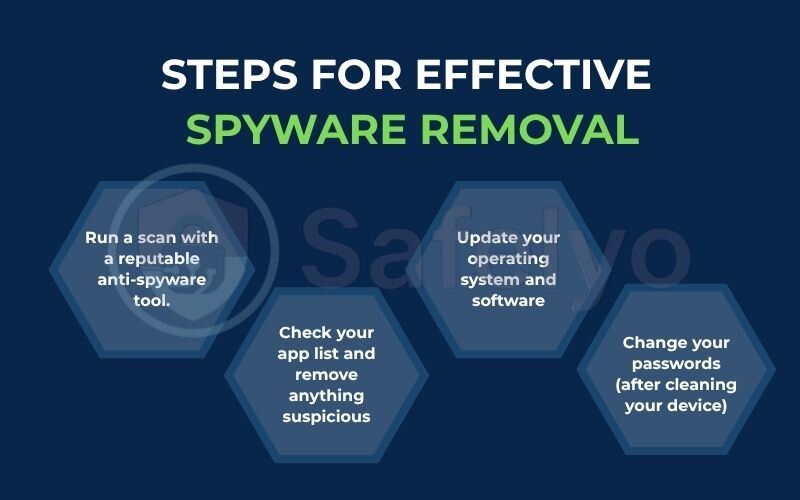
5.2. Proactive spyware protection strategies
Removing spyware is great, but not getting infected in the first place is even better. Here’s how you can fortify your digital life:
- Install powerful anti-malware/anti-spyware software. This is non-negotiable in today’s world. An active security suite is like having a 24/7 guard for your devices. It doesn’t just clean up messes; it stops threats before they can get in.
- Be skeptical of “free” offers and pop-ups. I always say, if you aren’t paying for a product, you often are the product. Be cautious with free software, and never click on pop-up ads that claim your device is infected or that you’ve won a prize. These are common traps.
- Enable two-factor authentication (2FA). This is one of the single best security measures you can take. Even if a keylogger steals your password, 2FA creates a second barrier – like a code sent to your phone – that prevents the attacker from getting in.
- Keep a lock screen on your phone. This simple habit is your best defense against the physical installation of stalkerware. If no one can get into your unlocked phone, they can’t install a tracking app on it.
While manual removal can work, a dedicated security tool is your best bet for finding and eliminating deep-rooted spyware. Explore Safelyo’s expert-tested reviews of the best anti-spyware software to secure your privacy today.
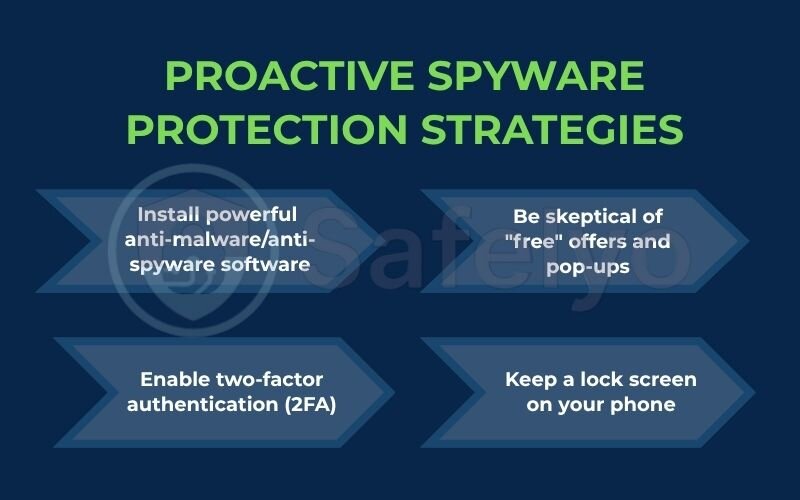
Read more:
6. FAQ about spyware
Spyware can be a confusing topic, so here are quick, direct answers to some of the most common questions I hear from users.
What is spyware in a computer?
In a computer context, spyware is a type of malicious software that installs itself without your knowledge to secretly record your activities. This can include logging your keystrokes to steal passwords, tracking your web browsing history, or taking screenshots of your screen.
Is spyware a type of virus?
No, they are different, though both are types of malware. A virus aims to replicate itself and spread to other computers, often causing damage. Spyware’s primary goal is to hide on a single device and secretly collect data without being detected.
What does spyware mean for kids?
For kids, spyware most often appears as either aggressive adware bundled with free games or as “stalkerware” apps installed by someone to monitor them without their knowledge. It can also refer to legitimate parental control apps, but the key difference is whether the child is aware of the monitoring in an age-appropriate way.
Are tracking cookies considered spyware?
It’s a gray area. Standard tracking cookies used for advertising are generally not considered spyware because their function is disclosed in privacy policies. However, highly aggressive tracking cookies that collect personally identifiable information without clear consent or are difficult to remove can be classified as spyware.
Can spyware be installed remotely?
Yes, absolutely. Most spyware infections happen remotely. This occurs when you click a malicious link in a phishing email, visit a compromised website, or download a trojanized application. The attacker never needs to physically touch your device.
How do I know if I have spyware?
The most common signs are a sudden slowdown of your device, rapid battery drain, an unexplained increase in data usage, and seeing new apps you don’t recognize. Using the checklist in this guide is a great way to start your assessment.
What is Spyware Quizlet?
When you see “spyware Quizlet,” it refers to the study sets and flashcards on the learning platform Quizlet that define spyware. Students and users create these to learn cybersecurity terms. It is not a type of spyware itself, but a resource to learn about it.
Is factory resetting my phone a good way to remove spyware?
A factory reset will remove most types of spyware, but it’s a drastic measure as it also erases all of your personal data (photos, contacts, etc.). Furthermore, if the spyware infected your cloud backup, you might reinstall it when you restore your data. It’s always best to try a reliable security app first.
7. Conclusion
Understanding what is spyware is the first and most critical step toward defending your digital life. It’s not just a technical threat; it’s a direct assault on your fundamental right to privacy, capable of turning your most trusted devices into tools of surveillance. But with the right knowledge, you can take back control.
Remember these key points to stay safe:
- Spyware operates in secret with the sole purpose of stealing your personal information.
- Be alert for tell-tale signs like rapid battery drain, slow performance, and unexplained data usage.
- Stalkerware on mobile devices is a growing and deeply personal threat, often installed by someone you know.
- Your best defense is a combination of cautious online behavior and powerful security software.
Your privacy is not something to be taken lightly. By being proactive, recognizing the warning signs, and equipping yourself with the right tools, you can shield your personal information from prying eyes. For ultimate peace of mind and protection against all forms of surveillance, dive into the in-depth guides in Antivirus Center of Safelyo and choose the right security solution for you.



